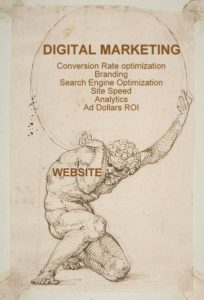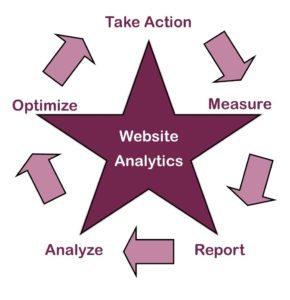It All Starts With a Website

The solid foundation of an effective digital marketing plan rests on the website. A quality website design can have a huge impact on almost all areas of your digital marketing strategy, making it important when considering those various elements in conjunction with one another.
Let’s see how website design impacts each element of digital marketing so you can see just how important it is to running your successful digital marketing campaign.
Conversion Rate Optimization (CRO)
The important thing about website design is how it communicates who you are and what your business is. People respond to impressions of trust and authority. If you go to a website and it is stock photos and there isn’t a feel of substance and authenticity behind it, would you feel comfortable spending your money there? Neither would your visitors.
It is important that your website looks well designed and authoritative in appearance.
That said, this doesn’t mean a simplistic design won’t work. A design that is too complex can have negative implications on both the user experience and the load time of the site. This is where a balance is needed. When considering the conversion rate of your website you need to ensure your design is simple enough to satisfy the user experience yet authentic enough to satisfy user trust.
Branding
While a component of your brand, your logo isn’t your brand. A brand is much more intangible and has more to do with feelings and how your company is perceived in the public and in certain circles or communities. Businesses go to great lengths to craft their brands and find innovative ways to share their brands. Whether increasing brand awareness, building brand equity, or launching a new brand, your company’s website plays an integral role in branding your company.
Your visual elements and stories have a huge impact on the emotions of the user experience, also known as UX. Provoking the right emotion increases the effectiveness of your website in appealing to your visitors and getting them engaged as well as supporting your brand.
Search Engine Optimization (SEO)
You want your website to rank high in Google searches. This is also the biggest reason I’ve seen for website redesigns – The current website simply doesn’t meet the requirements for ranking high in Google anymore. Because Google is always finding a new way, a new algorithm for ranking.
(Prepare for geek speak.) A good example of how SEO changes is “duplicate content.” To beef up website keywords, it was popular to repeat whole passages of keyword-rich content on pages and in blogs. This became a no-no. When there were multiple pieces of duplicate content it became difficult for search engines to decide which version is more relevant to a given search query. Then webmasters scrambled to remove duplicate content, there were even tools developed to help pin point offensive duplicates. Now Google has algorithms to determine the original source of the content and display that one.
Another consideration is the back-end design of a website. A website needs to have the functionality to input custom Meta descriptions, Alt tags and the like. It is essential to incorporate these elements within your design. (Okay, geek speak over, see not so bad.)
Site Speed
The design of a website has a huge impact on UX. Navigation must be simple and easy to use and ensure the speed of your site is fast. If a site or page does not load quickly enough, many users, particularly mobile users, will just move on. And they won’t return.
With short “attention spans”, site speed is now considered to be a ranking factor. Internet speeds have increased, likewise so have users’ impatience of page load time. Does your website use large images, videos and other elements that make your site slow to load? It may be negatively affecting your UX. There are ways of increasing this load time. Professional hosting, http compression, using the browsers cache and reducing unnecessary redirects (links to other pages or websites) are just a few methods for speeding things up.
During the design process it is critical to remember that the key goal of your website is to make it as easy as possible for your visitors to find out who you are, what you do and why they should care so they become your customers.
Analytics
 Collecting Analytics data is crucial to track how your visitors behave on your site. Do they enter through the home page, member or landing pages? Tracking what they do, how long they stay, etc., lets you know what is working and what is not and most importantly, where you may be losing your audience.
Collecting Analytics data is crucial to track how your visitors behave on your site. Do they enter through the home page, member or landing pages? Tracking what they do, how long they stay, etc., lets you know what is working and what is not and most importantly, where you may be losing your audience.
Your website needs to be set up in such a way to collect data relevant to user use. For instance, during the checkout process, what percentage of buyers complete the process? Do a large percentage leave during billing? Maybe payment options need to be expanded or simplified.
If you are unable to record this data because of the infrastructure of your website, then you are losing out on this valuable data.
Landing Pages
Landing page use has become a foundational element of online and offline marketing and should be used regardless of industry or engagement type. Landing pages can be used by any business whether you sell products from your website, want people to make an appointment or are trying to entice people into your store for your holiday sale.
Ads can drive users to your landing page for further details about a promotion or other event. Social media can direct users to your landing pages for coupons, a free ebook or guest pass, a book launch or to sign up for your email newsletter.
Using multiple ads, or ads in multiple places with a different landing page for each can quickly show you which ads in which venues are effective for your audience. Ads cost money, boosted pages and posts cost money. Landing pages are an effective way to judge the effectiveness of your marketing tools and thus, your marketing dollars ROI.
Add It All Up
Now you can see how web design and development impacts the most important aspects of your digital marketing strategy. It all starts with a website. Get it right from the start and you’ll reap the benefits of your efforts.

